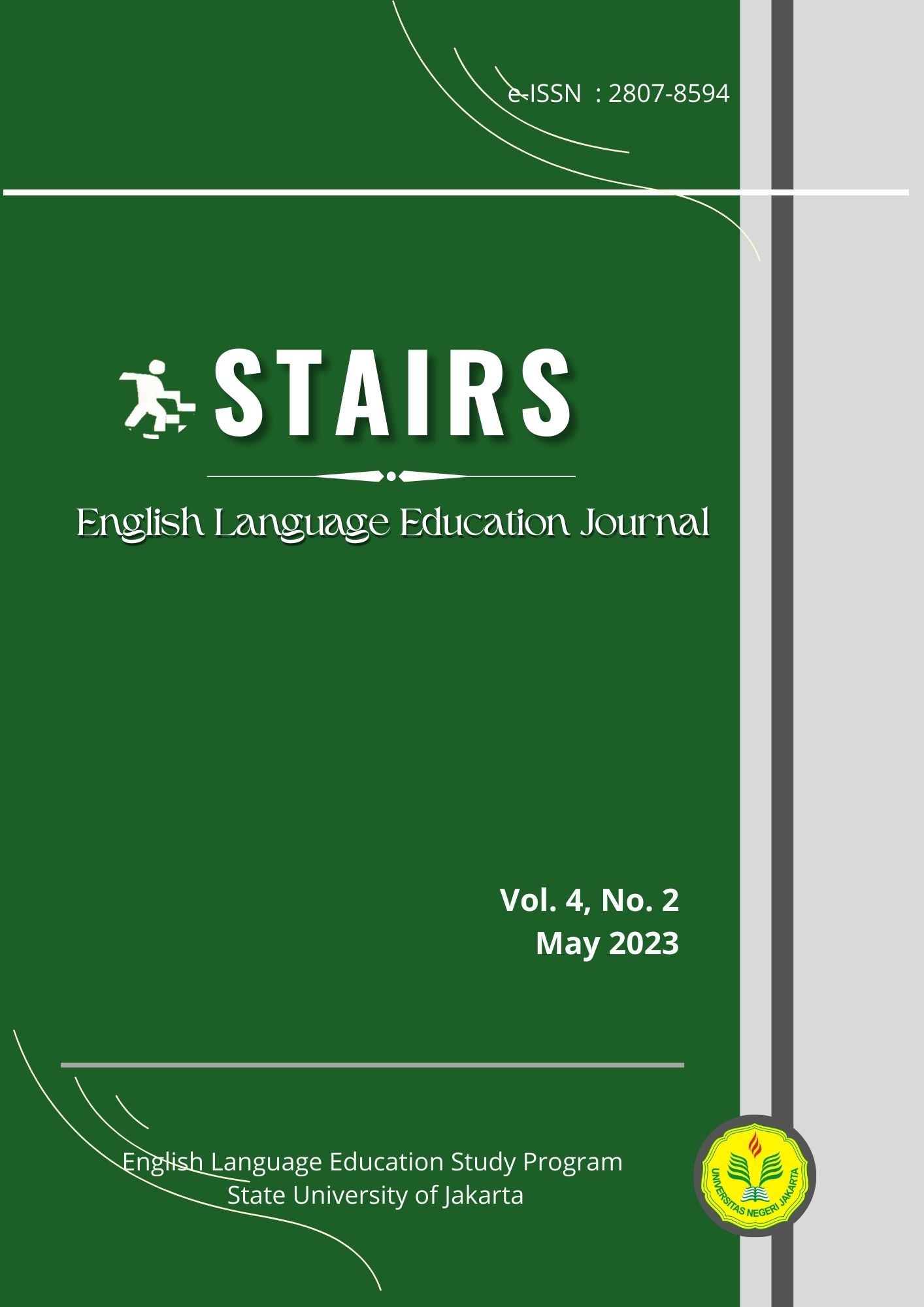The Existence of CEFR Interaction Competence of Communicative Language Activities in TikTok
DOI:
https://doi.org/10.21009/stairs.4.2.2Keywords:
CEFR, Communicative language activities, Interaction competence, TikTokAbstract
The increasing popularity of social media apps has the potential to provide teachers and students with a platform for innovative and engaging language learning, one of which is TikTok. However, there is a lack of investigation and explanation on to what extent and how videos available on TikTok can enhance interaction and activities in language learning classrooms. Therefore, this study aims to examine the existence of CEFR interaction competence in communicative activities and its level on selected TikTok videos. This study applied a content analysis method with a qualitative approach using the CEFR reference of the illustrative descriptor scale. The top 250 learning videos from the search results for the hashtag #learnenglish were collected. The findings show that most activities were found in overall oral interaction with a score of 291 and the level was A2 with 46% of occurrences. The findings demonstrate that TikTok learning videos are well-suited as teaching materials for classes at the A2 proficiency level with general oral interaction activities.
References
Common European Framework of Reference. (2020). Companion Volume. In New Cambridge Modern History (Vol. 13). http://universitypublishingonline.org/cambridge/histories/ebook.jsf?bid=CBO9781139055895%5Cnhttp://www.cambridge.org/ca/academic/subjects/history/european-history-general-interest/new-cambridge-modern-history-volume-13?format=HB
Creswell, J. W., & Creswell, J. D. (2018). Mixed Methods Procedures. In Research Design: Qualitative, Quantitative, and Mixed Methods Approaches.
Ferstephanie, J., & Pratiwi, T. L. (2021). TikTok Effect to Develop Students’ Motivation in Speaking Ability. English Education : English Journal for Teaching and Learning, 9(02), 162–178. https://doi.org/10.24952/ee.v9i02.4805
Hazar, E. (2021). The influence of the CEFR in Turkish national curriculum. African Educational Research Journal, 9(2), 551–561. https://doi.org/10.30918/aerj.92.21.087
Herlisya, D., & Wiratno, P. (2022). Having Good Speaking English through Tik Tok Application. Journal Corner of Education, Linguistics, and Literature, 1(3), 191–198. https://doi.org/10.54012/jcell.v1i3.35
Herwanto, W. H. (2022). Exploring Tiktok App in Learning Speaking Using Role-Play Activities for ESL Learners in Secondary School. RETAIN (Research on English Language Teaching in Indonesia), 10(01), 76–85.
Huttayavilaiphan, R. (2022). “I Apology no no I Mean I Am Sorry … Please Let Me Explain That First”: Enhancing Communicative Language Competence of Thai University Students Through CEFR-Based Online Intercultural Communication. Journal of Education and Learning, 11(1).
Johnson, S. B. (2015). Reaping the benefits of using Twitter in advanced language learning *. 7, 97–109.
Kharis, Ebner, M., Wijayati, P. H., Hidayat, E., & Afifah, L. (2020). Microblogging with Padlet: Students’ new writing experience on A2-B1 common European framework of reference for languages (CEFR). International Journal of Emerging Technologies in Learning, 15(1), 176–187. https://doi.org/10.3991/ijet.v15i01.11804
Maryo, F. A. A. (2021). The Issues of the Implementation of CEFR in Indonesia. Aplinesia: Journal of Applied Linguistics Indonesia, 5(1). http://dx.doi.org/10.30595/aplinesia.v5i1.12080
Mayring, P. (2015). Qualitative Content Analysis: Theoretical Background and Procedures. 365–380. https://doi.org/10.1007/978-94-017-9181-6_13
Nabilah, A., M.P, D. L., Lazuwardiyyah, F., Syaifuddin, S., & Abdi, W. M. (2021). Students’ perception toward the use of TikTok video in learning writing descriptive text at MAN 1 Gresik. Journal of Research on English and Language Learning (J-REaLL), 2(1), 164. https://doi.org/10.33474/j-reall.v2i1.9017
Rahmawati, A., Syafei, M., & Prasetiyanto, M. A. (2023). Improving Speaking Skills through Tiktok Application: An Endevour of Utilizing Social Media in Higher Education. Journal of Languages and Language Teaching, 11(1), 137. https://doi.org/10.33394/jollt.v11i1.6633
Sarangapani, S. and Hashim, H. (2022) “InstaGrammar!” Incorporating Instagram Reel to Enhance English as a Second Language Learners’ Grammatical Accuracy. Creative Education, 13, 1965-1980. doi: 10.4236/ce.2022.136122.
Setyowati, R., Setiawati, B., & Khurniawati, D. R. (2022). A Study of CEFR Level B1 Vocabularies on Instagram. Proceeding of International Conference on Science, Health, and Technology, 3, DOI. https://doi.org/10.47701/icohetech.v3i1.2263
Shopia, K., Sabila, D., & Purnawati. (2022). Students’ Interest in Learning English through YouTube (A Case Study in Senior High School of Sekolah Alam Cikeas Bogor). STAIRS: English Language Education Journal, 3 (1).
Sinta, I, & Zulfitri. (2022). Students’ Experience in Vocabulary Memorizing of Adjectives by Using TikTok Duet Video. Cybernetics: Journal Educational Research and Social Studies, 3(1), 40–52. https://pusdikra-publishing.com/index.php/jrss/article/view/366/312



